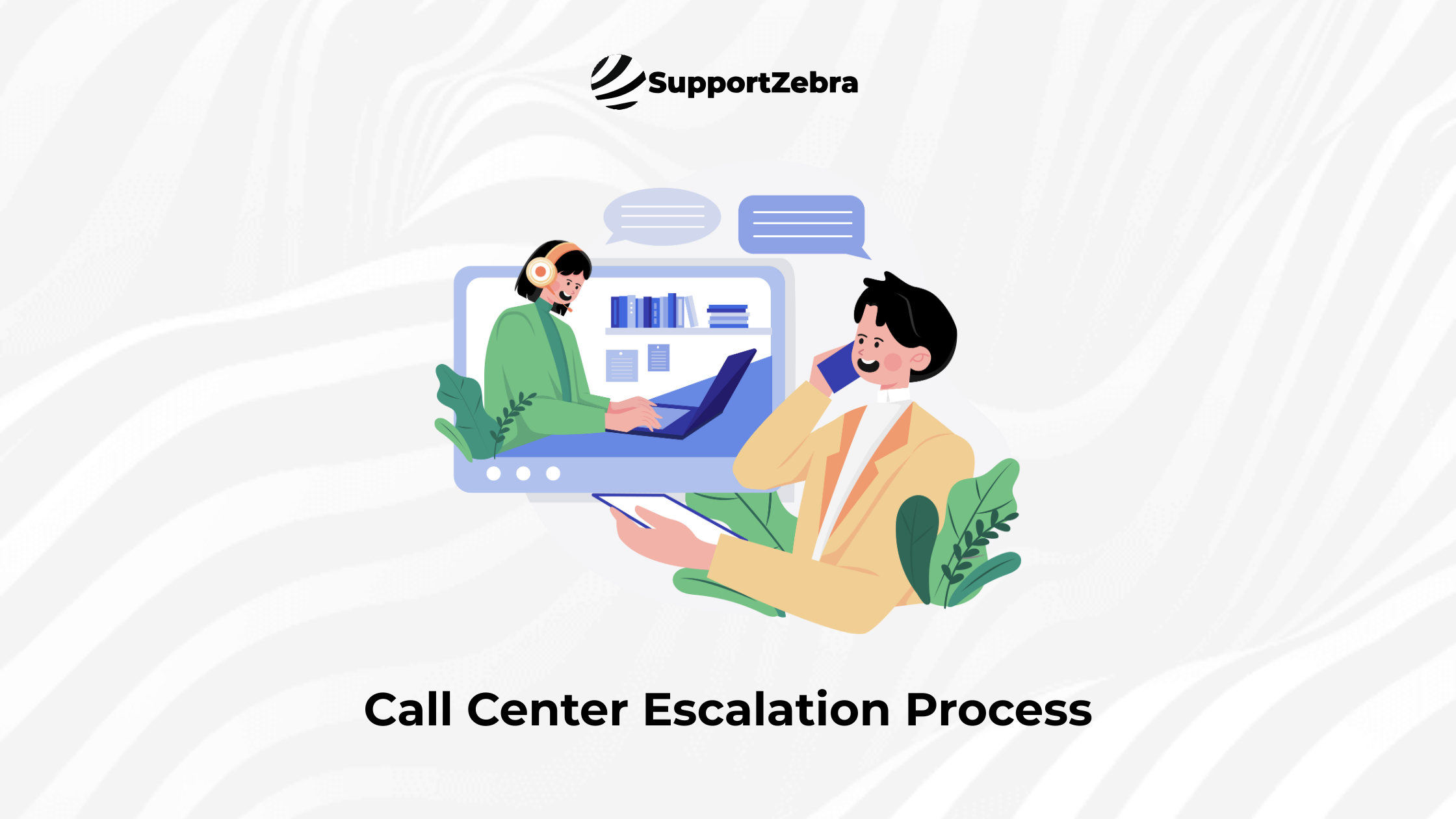Your Guide to the Call Center Escalation Process
Key Takeaways:
- Without structure, escalations lead to frustration, lost business, and brand damage.
- Hierarchical, functional, priority, and automatic escalations help route issues to the right people at the right time.
- AI tools streamline workflows while well-trained agents prevent unnecessary escalations and improve first-contact resolution.
- Detailed records and timely coaching help identify trends, improve performance, and reduce repeat issues.
When a frustrated customer asks to “speak to a manager,” it’s often a sign that something in the support process has broken down. As a call center leader, you know how quickly a minor issue can escalate into a major complaint, damaging trust, increasing churn, and stressing your agents. Without a clear and effective escalation process in place, you risk losing more than just customer satisfaction; you risk your brand’s reputation.
That’s why having a structured, empathetic, and well-trained escalation framework isn’t optional; it’s essential. In this guide, we’ll walk you through everything you need to know to build a call center escalation process that restores confidence, protects your team, and delivers real resolution when it matters most.
What is the Call Center Escalation Process, and Why is it Important?
The call center escalation process is a structured method used to transfer customer issues that frontline agents cannot resolve to higher levels of expertise or authority within the organization. This process ensures that complex or sensitive problems receive the appropriate attention, improving customer satisfaction and operational efficiency. Escalations typically occur when an agent encounters a problem that falls beyond their scope, such as technical issues, billing disputes, or urgent complaints that require managerial intervention.
Effective escalation management is crucial because it:
- Prevents customer frustration by providing timely resolutions
- Ensures issues are handled by the right personnel with the necessary skills or authority
- Helps maintain service level agreements (SLAs) and customer trust
- Identifies systemic problems that may require organizational changes
Without a clear escalation process, customer issues can fall through the cracks, resulting in delays and damage to the company’s reputation.
What Are the Different Types of Call Center Escalation?
Call center escalations generally fall into four main categories, each serving a specific purpose:
- Hierarchical Escalation: The issue is passed up the chain of command within the same department, from frontline agents to supervisors, managers, and sometimes executives. This type relies on seniority and decision-making authority to resolve complex or sensitive issues.
- Functional Escalation: The call is transferred to a specialized team or department with the exact expertise required, regardless of hierarchy. For example, billing issues are handled by the accounts department, while the compliance department addresses legal concerns.
- Priority Escalation: Urgency dictates the speed and level of escalation. High-priority cases, such as widespread outages or critical product failures, are immediately expedited to senior staff.
- Automatic Escalation: Technology-driven systems, often powered by AI, automatically route calls based on predefined criteria like issue type or customer status, improving efficiency and response times.
Understanding these types enables organizations to tailor their escalation workflows to meet the diverse needs of their customers effectively.
How Does a Typical Call Center Escalation Flow Work?
The escalation flow describes the path an issue takes from the initial agent to resolution. It varies depending on organizational size and escalation type but generally follows these steps:
- Frontline Agent Recognition: The agent identifies that the issue cannot be resolved at their level and initiates escalation while maintaining communication with the customer.
- Routing to Appropriate Level or Department: Depending on the issue, the call is either escalated hierarchically (to a supervisor or manager) or functionally (to a specialized team).
- Supervisor or Manager Intervention: The higher-level staff assesses the problem, applies their authority or expertise, and attempts to resolve it. They may approve exceptions or compensations if necessary.
- Further Escalation if Needed: For critical or unresolved issues, escalation may continue to senior leadership or cross-functional teams, especially if systemic changes are required.
- Issue Resolution and Feedback: Once resolved, the outcome is documented, and feedback loops are closed to prevent repeat escalations.
This flow is dynamic; in some cases, it skips levels or switches between hierarchical and functional escalation paths to adapt to the specific situation.
What Are the Best Practices for Managing Call Center Escalations?
To optimize escalation management, organizations should adopt these best practices:
- Define Clear SLAs: Establish service level agreements that specify how quickly escalations should be handled, setting clear expectations for both customers and agents.
- Create an Escalation Matrix: Develop a clear, documented matrix that outlines who is responsible for each escalation level and type, thereby minimizing confusion and delays.
- Equip Agents with the Right Tools: Use integrated communication platforms that support omnichannel interactions and enable seamless internal collaboration.
- Train Agents on High-Risk Scenarios: Preload training with common escalation triggers, such as billing disputes or angry customers, to reduce the frequency of escalations.
- Monitor and Analyze Escalations: Utilize quality assurance tools and speech analytics to identify patterns, coach agents, and continually improve processes.
- Close Feedback Loops Quickly: Provide timely feedback to agents after escalations to correct mistakes and enhance customer handling skills.
- Document Every Escalation: Keep detailed records of escalations, including the issue, resolution steps, and outcomes, to build a knowledge base for future reference and support.
Implementing these practices leads to faster resolutions, reduced customer churn, and higher agent confidence.
How Can Technology Improve the Escalation Process?

Modern call centers increasingly rely on technology to streamline escalation management:
- AI and Automation: Automatically route calls based on issue type, customer priority, or agent availability, reducing wait times and misrouting.
- Integrated Communication Platforms: Combine voice, messaging, social media, and video in one interface, enabling agents to access complete customer histories and collaborate internally without switching tools.
- Speech Analytics: Analyze calls in real time to detect escalation triggers and alert supervisors for immediate intervention.
- Escalation Tracking Software: Maintain detailed logs of escalations, generate reports on trends, and support coaching efforts to drive effective outcomes.
These technologies enhance accuracy, speed, and agent empowerment, ultimately improving the customer experience.
How Can Technology Improve the Escalation Process?
Modern call centers increasingly rely on technology to streamline escalation management:
- AI and Automation: Automatically route calls based on issue type, customer priority, or agent availability, reducing wait times and misrouting.
- Integrated Communication Platforms: Combine voice, messaging, social media, and video in one interface, enabling agents to access complete customer histories and collaborate internally without switching tools.
- Speech Analytics: Analyze calls in real time to detect escalation triggers and alert supervisors for immediate intervention.
- Escalation Tracking Software: Maintain detailed logs of escalations, generate reports on trends, and support coaching efforts to drive effective outcomes.
These technologies enhance accuracy, speed, and agent empowerment, ultimately improving the customer experience.
What Challenges Do Call Centers Face in Escalation Management?
Despite best efforts, call centers often encounter obstacles such as:
- Undertrained or Overwhelmed Agents: Agents lacking the necessary skills or support may escalate calls prematurely or mishandle them.
- Poor Documentation: Incomplete or unclear case notes cause delays and frustration when escalations are handed off.
- Misrouting Escalations: Sending issues to the wrong department or level leads to repeated transfers and unhappy customers.
- Lack of Clear Escalation Paths: Without a defined escalation matrix, agents waste time determining who to escalate to, resulting in increased customer wait times.
- Delayed Feedback: Slow coaching and feedback cycles hinder agents’ ability to learn and improve quickly.
Addressing these challenges requires ongoing training, process refinement, and investment in supportive technology.
How Can Training Reduce Escalations and Improve Outcomes?
Training is a cornerstone of effective escalation management. Key training strategies include:
- Scenario-Based Learning: Utilize real-life, high-risk situations to prepare agents for challenging calls and minimize unnecessary escalations.
- Coaching on Communication Skills: Teach agents how to de-escalate tense situations and empathize with customers.
- Regular Feedback Sessions: Provide timely, constructive feedback based on recorded calls and QA scorecards.
- Cross-Departmental Knowledge: Familiarize agents with other teams’ roles to improve functional escalations and first-contact resolutions.
Well-trained agents handle more calls independently, which boosts customer satisfaction and reduces operational costs.
What Role Does Documentation Play in Escalation Success?
Documentation is vital for seamless escalation handoffs and continuous improvement:
- Captures Issue Details: Logs what was tried, customer interactions, and technical data to avoid redundant troubleshooting.
- Supports Accountability: Tracks who handled the escalation and the resolution path for transparency.
- Enables Knowledge Sharing: Creates a repository of resolved cases that agents can reference to resolve future issues more quickly.
- Facilitates Analytics: Provides data for identifying escalation trends and training needs.
Ensuring thorough, clear documentation is a best practice that underpins every successful escalation.
How Do You Measure the Effectiveness of Your Escalation Process?
Measuring escalation effectiveness involves tracking key performance indicators (KPIs) such as:
- Escalation Rate: Percentage of calls escalated versus total calls; a high rate may indicate training or process issues.
- Resolution Time: The average time taken to resolve escalated issues; shorter times indicate efficient handling.
- Customer Satisfaction Scores: Feedback from customers post-escalation to assess service quality.
- Repeat Escalations: The frequency of the same issue being escalated multiple times, signaling systemic problems.
- Agent Performance Metrics: Identify individual escalation trends to pinpoint coaching opportunities.
Regularly reviewing these metrics helps refine escalation workflows and improve overall customer experience.
What Steps Should You Take After Resolving an Escalated Call?
Closing the loop after an escalation is as important as the resolution itself. Recommended steps include:
- Communicate Resolution Clearly: Ensure the customer understands the outcome and any next steps.
- Document the Final Outcome: Update records with resolution details and any follow-up actions.
- Provide Feedback to Agents: Share insights on what went well and what could be improved to enhance future performance.
- Analyze for Root Causes: Determine if the issue indicates a larger problem requiring process or product changes.
- Update Training Materials: Incorporate lessons learned into agent onboarding and ongoing education.
Taking these actions transforms escalations from isolated incidents into opportunities for continuous improvement.
Reduce Customer Frustration with Better Escalations

Escalations are not a failure; they’re a second chance. With the right process, tools, and training, your call center can transform even the most challenging interactions into opportunities to rebuild trust and strengthen relationships. Start by equipping your agents, supporting your supervisors, and ensuring a smooth customer journey at every level.
Done right, the call center escalation process becomes a pillar of excellent service, not just a safety net.
Need a smarter way to handle escalations? SupportZebra can help streamline your call center escalation process with trained agents, customized workflows, and round-the-clock support, ensuring that no issue falls through the cracks. Let’s turn escalations into opportunities for loyalty. Talk to us today.

